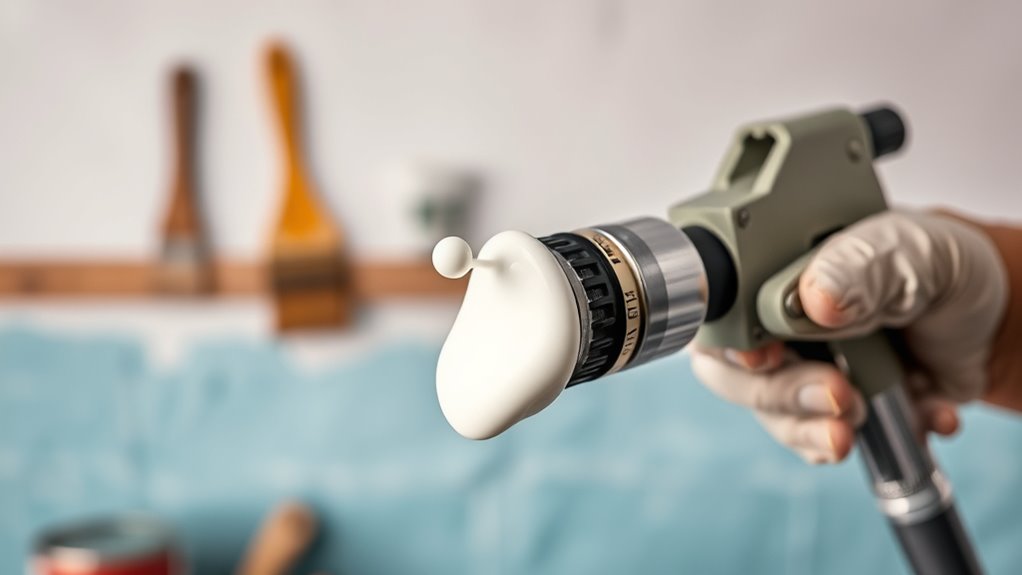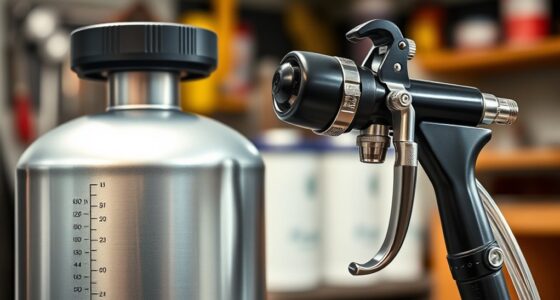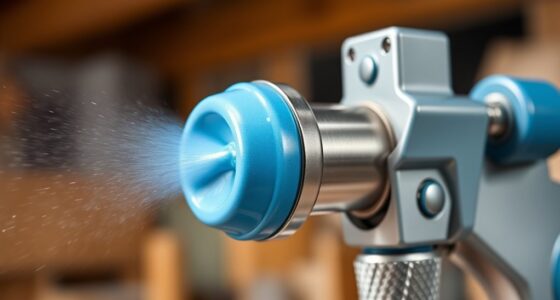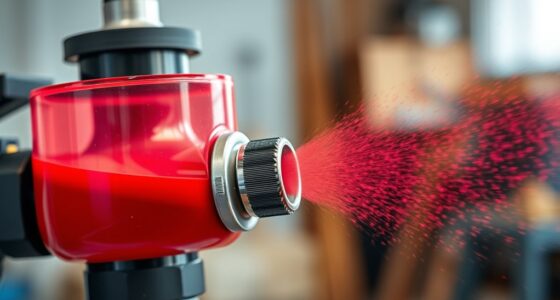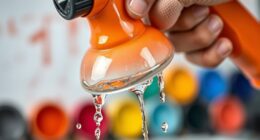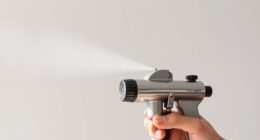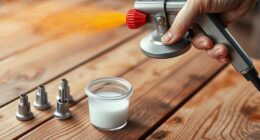Yes, you often need to thin paint for an airless sprayer to guarantee smooth, even application. Thinning reduces the paint’s viscosity, helping prevent clogs, splattering, and uneven coverage. The typical ratio is around 10-15%, but it depends on the paint and equipment. Properly preparing your paint can make a big difference in your results. Keep in mind the specific guidelines to avoid common issues—more tips can help you spray like a pro.
Key Takeaways
- Latex and acrylic paints typically need thinning for smooth, even spray, while oil-based paints may require less or no thinning.
- Thinning paint helps prevent clogging, splattering, and uneven coverage during spraying.
- Test the paint with a small amount before spraying to determine if thinning improves flow and atomization.
- Use a thinning ratio of 10-15%, mixing thoroughly and adjusting as needed based on test results.
- Properly thinned paint ensures a professional finish, reduces equipment issues, and enhances spray performance.
Understanding the Types of Paint Suitable for Airless Sprayers
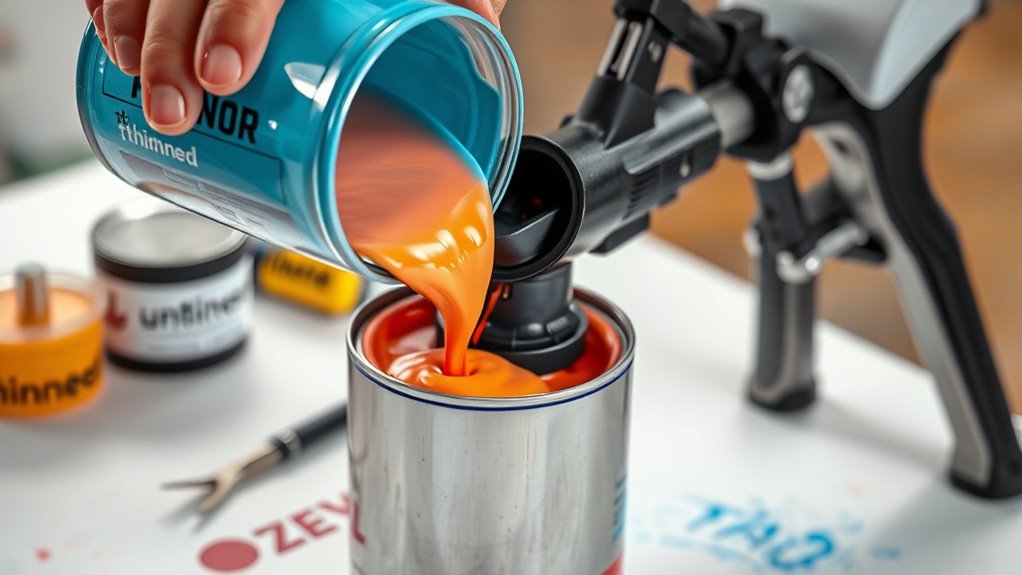
Not all paints are compatible with airless sprayers, so it’s important to choose the right type for your project. Latex and acrylic paints work well because they have suitable viscosity and dry quickly. Oil-based paints can also be used but require careful handling and proper clean-up. When selecting paint, consider brush techniques used for touch-ups or detail work, as some paints are better suited for brushes than sprayers. Proper paint storage is essential; keep your paint sealed tightly to prevent drying out or thickening, which can clog your sprayer. Thin your paint only if necessary, based on the manufacturer’s recommendations, to ensure smooth application. Using compatible paint types and managing storage correctly helps you achieve a professional finish with your airless sprayer. Additionally, understanding the best paint types for airless sprayers ensures optimal results and minimizes maintenance issues. Being aware of paint viscosity can also help prevent clogging and ensure a smooth spray pattern. To enhance your spraying experience, selecting appropriate thinning techniques can make the process more efficient and effective.
How to Recognize When Your Paint Needs Thinning
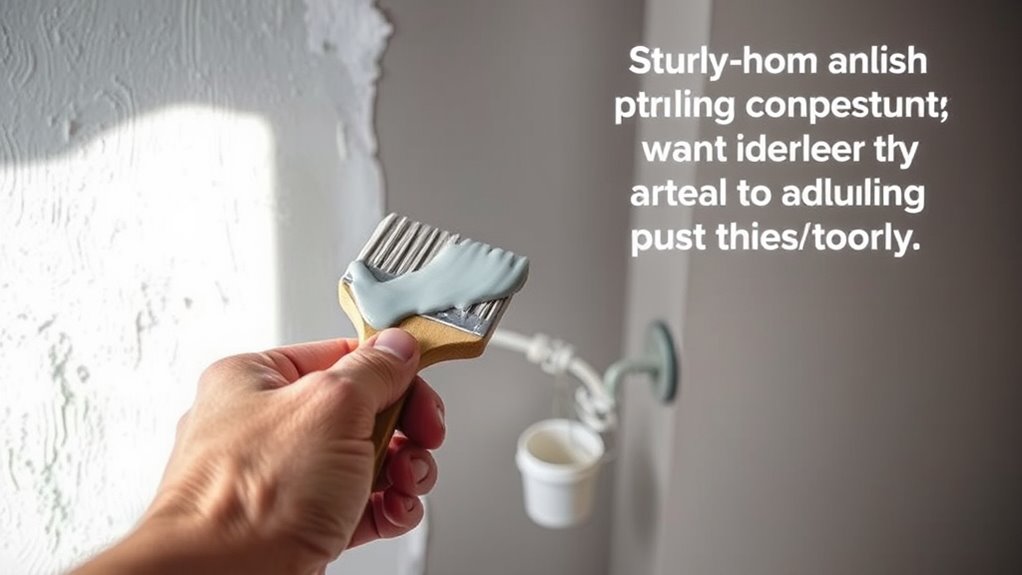
Before starting to spray, it’s important to determine if your paint is properly thinned; if it’s too thick, it can clog your sprayer or produce uneven coverage. One way to recognize this is by checking how the paint flows and sprays. If it splatters or leaves uneven coats, it likely needs thinning. Pay attention to color matching—if the paint appears inconsistent or streaky, thinning may improve flow and consistency. Additionally, observe the drying times; if your paint takes much longer to dry than normal, it could indicate excessive thickness. Properly thinned paint will spray smoothly, match your color expectations, and dry evenly. Always test a small amount before committing to your entire project to ensure ideal results.
Proper Techniques for Thinning Paint for Optimal Spray Performance
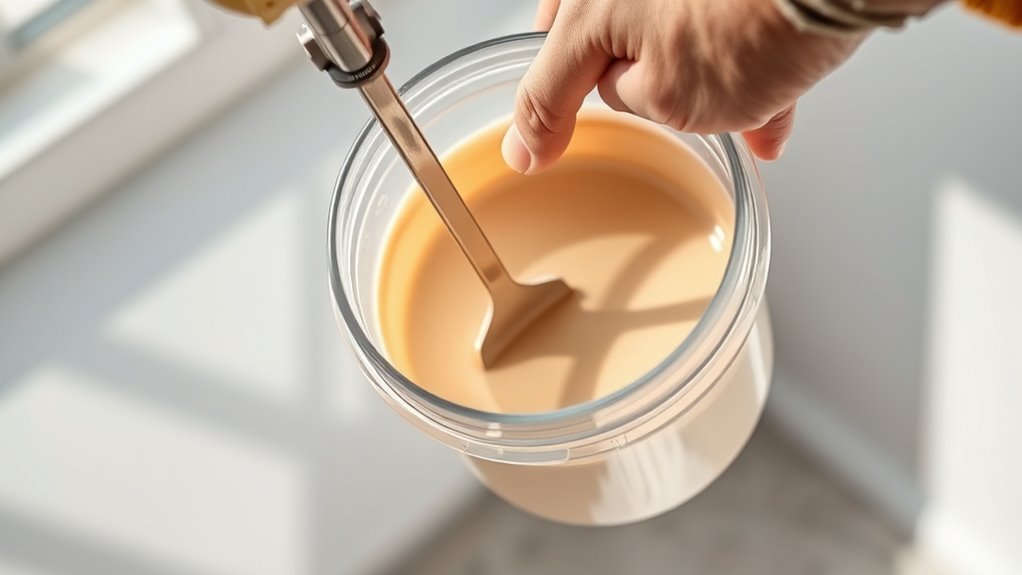
To get the best spray results, you need to use the right thinning ratios and mix your paint thoroughly. Always test the consistency before spraying to avoid clogs or uneven coverage. Proper techniques guarantee your paint flows smoothly and adheres properly. Additionally, selecting the appropriate tuning options can optimize your equipment’s performance for a smoother application. Using professional equipment and understanding industry trends can further enhance your results and efficiency.
Appropriate Thinning Ratios
What’s the ideal ratio for thinning paint in an airless sprayer? Typically, a 10-15% thinning ratio works best, but it depends on your paint and project. Proper ratios help ensure color matching and paint compatibility, reducing issues like clogging or uneven spray. To get it right:
- Start with 1 part water or thinner to 10 parts paint.
- Mix thoroughly and test spray on a scrap surface.
- Adjust the ratio slightly if needed, keeping it within 10-20%. Additionally, understanding paint chemistry can help determine the best thinning practices for different types of paint. Being aware of headphone compatibility is also important when using audio devices during your work.
- Always check manufacturer recommendations for specific paint types.
- Remember that Nutritional advantages of properly thinned paint can include smoother application and better finish quality. Proper equipment maintenance also plays a role in achieving optimal spray results.
Using the correct ratio maintains consistent color matching and prevents problems caused by over-thinning or under-thinning. Remember, the goal is a smooth, even application without compromising paint integrity or finish quality.
Mixing and Testing Tips
Proper mixing is essential for achieving a smooth, consistent paint flow when thinning for an airless sprayer. Start by thoroughly blending the paint and thinner to ensure even color matching and avoid clumps. Use a clean container to prevent contamination and make cleanup procedures easier afterward. Before spraying, test the mixture on a scrap surface to check for proper flow and atomization. Adjust the thinning ratio if the paint drips or splatters, aiming for a smooth, even spray. Keep your sprayer’s filters clean to prevent blockages. Proper testing helps you fine-tune the mixture, saving time and reducing waste. Consistent mixing and testing ensure ideal spray performance and a professional finish. Additionally, understanding the Volkswagen Tuning concepts can help you select compatible additives or modifications for improved results. Recognizing the importance of tuning techniques can further optimize your spraying process and achieve better coverage. Remember to check the paint viscosity to ensure it’s within the recommended range for your sprayer, which is crucial for optimal atomization and finish quality. Also, paying attention to material compatibility ensures that the paint will adhere well and last longer.
Equipment Specifications and Manufacturer Recommendations
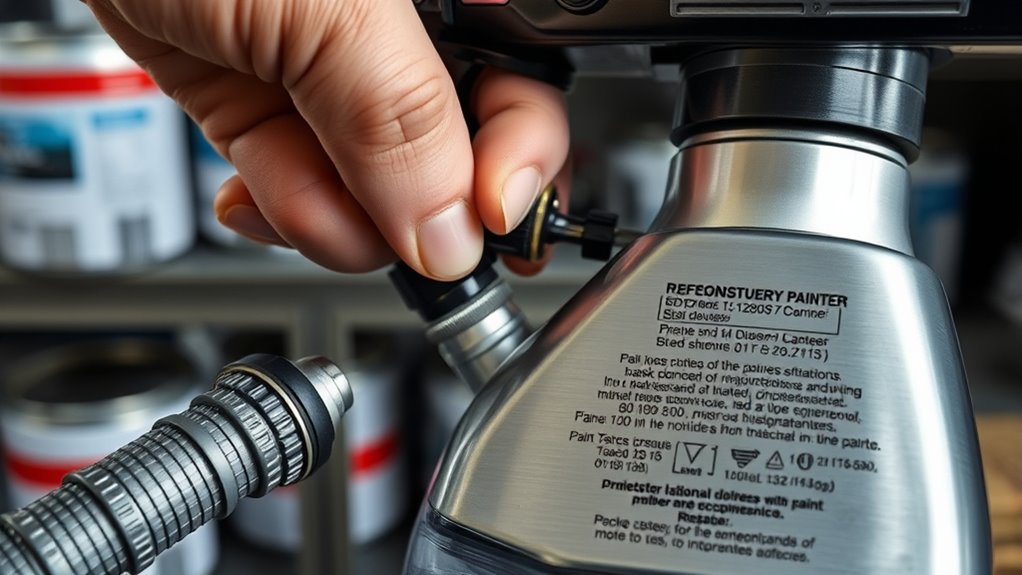
Understanding your airless sprayer’s equipment specifications and manufacturer recommendations is essential for achieving ideal results. These guidelines help you determine the correct paint viscosity and spray pressure needed for excellent performance. Ignoring them can lead to poor spray patterns or equipment damage. Additionally, adhering to these recommendations can help prevent appliance compatibility issues that may arise from improper usage. Consulting the manufacturer’s instructions can also provide insights into paint thinning requirements that are specific to your sprayer model, ensuring optimal operation and longevity.
Common Issues Caused by Not Thinning Paint Appropriately
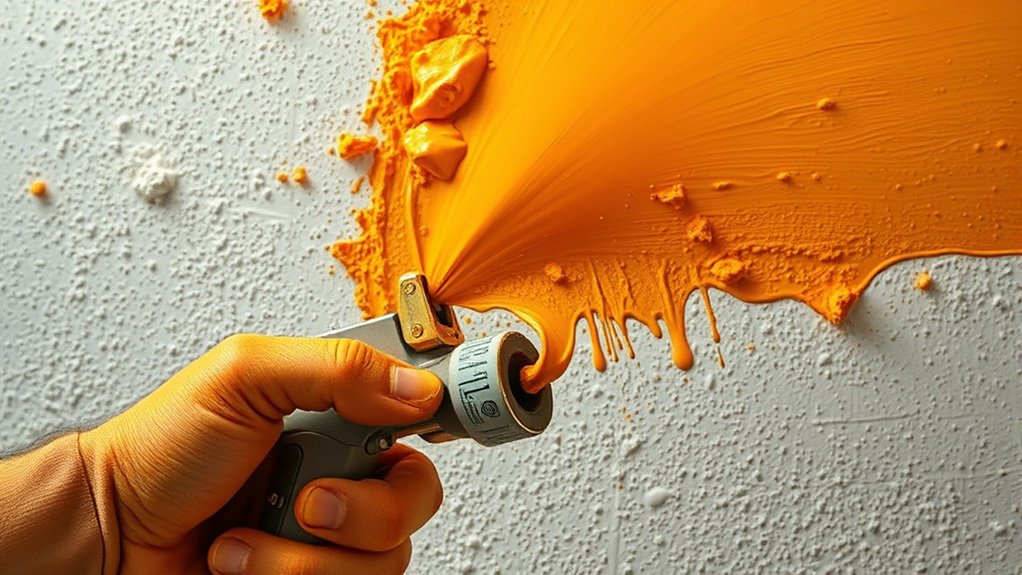
When you don’t thin paint properly, you might notice clogs and bubbles in your sprayer, which can slow down your project. An uneven spray pattern can also occur, making your finish look patchy and unprofessional. Additionally, you’ll likely see reduced paint coverage, forcing you to apply multiple coats to get the desired result. Proper thinning ensures optimal exfoliation, leading to smoother application and better overall results. Ensuring the correct paint consistency is essential for achieving a professional-looking finish. Proper preparation, including understanding the paint mixture needed, can help prevent common issues caused by improper thinning. Maintaining the proper system performance of your sprayer through correct paint viscosity also contributes to consistent results and prolongs the lifespan of your equipment.
Clogs and Bubbles
Failing to thin paint correctly can lead to clogs and bubbles in your airless sprayer, causing frustrating interruptions during your project. When paint isn’t the right viscosity, it can cause nozzle clogging, disrupting the spray pattern. Bubbles may form if the paint is too thick, leading to uneven coverage and splattering. To avoid these issues, keep these points in mind:
- High viscosity increases the risk of nozzle clogging.
- Thick paint traps air, creating bubbles during spraying.
- Proper thinning ensures smooth flow and consistent spray.
- Regularly check and adjust paint viscosity before use.
- Understanding paint consistency helps prevent common spraying problems. Properly maintaining the correct paint viscosity ensures optimal performance and reduces the likelihood of blockages, especially when considering appropriate dilution ratios for your project. Using a paint thinned to the right consistency can significantly improve application and reduce cleanup time. Additionally, being aware of the tuning requirements of your equipment can help achieve the best results.
Uneven Spray Pattern
An uneven spray pattern often results from paint that isn’t thinned properly, causing inconsistent flow through the sprayer. When the paint is too thick, you may notice visible brush strokes or drips on your surface, which indicates poor atomization. Thick paint can also lead to uneven color mixing, leaving patches of lighter or darker areas. This uneven distribution happens because the sprayer struggles to atomize the paint smoothly, resulting in inconsistent spray patterns. To fix this, you should thin the paint to achieve a more fluid consistency, ensuring a steady, even flow. Proper thinning helps the sprayer produce a uniform spray pattern, reducing brush strokes and promoting consistent color mixing across your project.
Reduced Paint Coverage
Thinning paint properly not only improves spray pattern consistency but also directly affects how much surface coverage you achieve. When paint isn’t thinned correctly, poor paint consistency can cause the sprayer to clog or push less material, resulting in reduced coverage. This means you’ll need more coats and more time to finish your project. To avoid this, ensure proper sprayer maintenance and adjust the paint’s viscosity. Additionally, using the correct type of essential oil for respiratory health can help clear any lingering fumes or irritation caused by improperly thinned paint. Here are key points to consider: 1. Thick paint can clog the nozzle, reducing flow and coverage. 2. Improper thinning causes inconsistent spray, wasting material. 3. Clogged sprayers require more frequent cleaning, lowering efficiency. 4. Proper paint consistency helps achieve maximum coverage in fewer coats. Regularly checking the filter indicators and maintaining your equipment can prevent many common issues. Thinning paint appropriately ensures better spray flow, optimizing surface coverage.
Tips for Achieving a Smooth and Even Finish Without Over-Thinning

To achieve a smooth and even finish without over-thinning, maintaining the right paint consistency is vital. Start by regularly inspecting your paint and stirring thoroughly before use. Proper paint storage is also essential; keep paint sealed tightly and store it in a cool, dry place to prevent it from thickening or drying out. Good brush maintenance helps ensure your tools stay clean and free of debris, which promotes even application. Remember, a well-maintained brush applies paint smoothly, reducing the need for excessive thinning. Don’t rush the process—apply thin, even coats, and allow each to dry before adding the next. This approach minimizes drips and brush marks, resulting in a professional-looking, uniform finish without the risk of over-thinning.
Frequently Asked Questions
Can I Use Water-Based Paint in an Airless Sprayer Without Thinning?
You can use water-based paint in your spray equipment without thinning, but it’s best to verify the paint’s consistency first. Proper paint mixing ensures it flows smoothly and adheres well. If the paint is too thick, add a small amount of water gradually until it reaches the right consistency. Always test the mixture in your airless sprayer to prevent clogs or uneven spraying, optimizing your project results.
Does Temperature Affect the Need for Thinning Paint in Sprayers?
Imagine your paint as a river flowing smoothly. When temperature drops, it’s like freezing parts of that river, increasing viscosity change and making it thicker. This temperature impact means you might need to dilute your paint more to guarantee proper sprayability. Hotter weather, conversely, thins the paint naturally. So, yes, temperature influences whether you need to thin your paint, as it affects viscosity and spray consistency.
How Does Paint Viscosity Influence Thinning Requirements?
Paint viscosity directly impacts thinning needs because it determines the paint’s consistency. You should measure viscosity to decide if thinning is necessary, as thicker paint with high viscosity may clog your sprayer. If the viscosity measurement indicates the paint is too thick, thinning will improve flow and atomization. Adjust the paint’s consistency until it flows smoothly, ensuring a clean, even application with your airless sprayer.
Are There Eco-Friendly Thinning Agents Suitable for Airless Sprayers?
You wonder if eco-friendly thinning agents suit your airless sprayer. Natural thinners and eco-friendly solvents are great options, as they reduce harmful emissions and are safer for the environment. These alternatives work effectively to thin paint without compromising quality. Always check your paint’s manufacturer recommendations, but generally, natural thinners like water or plant-based solvents can help you achieve a smooth, even spray while keeping your project eco-conscious.
Can Over-Thinning Paint Cause Damage to the Sprayer?
Did you know that over-thinning paint can lead to a 30% increase in clogging issues? When you over-thin, the paint’s consistency becomes too runny, risking damage to your sprayer. This not only hampers performance but also shortens its longevity. Keep an eye on paint consistency, and avoid over-thinning to guarantee your sprayer runs smoothly and lasts longer, saving you time and money in the long run.
Conclusion
In the end, thinning paint for your airless sprayer is like tuning a fine instrument—you’ll achieve a harmony of smooth, even coverage. By understanding your paint’s needs and following proper techniques, you’ll prevent mishaps and guarantee a flawless finish. Remember, patience and attention to detail are your best tools—think of it as nurturing a masterpiece, where every drop and stroke counts toward a picture-perfect result.
A seasoned painter with over 15 years in the industry, Mike transitioned from hands-on painting projects to the digital world of paint sprayers. His extensive experience gives him a unique perspective on what users truly need when it comes to painting tools. As the Editor in Chief of Paint Sprayer Zone, Mike ensures that every piece of content not only provides value but also reflects the realities of painting — the challenges, the joys, and the intricate details.
